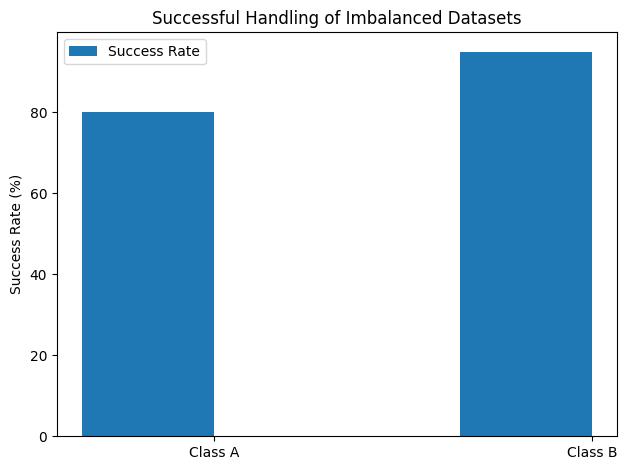Contents hideLearnings from AI Software Handling Imbalanced Datasets
You will learn:
– Definition and challenges of imbalanced datasets in AI
– Impact of imbalanced data on AI performance
– Techniques, machine learning algorithms, evaluation metrics, case studies, best practices, future trends, and ethical considerations in handling imbalanced datasets
How does AI software handle imbalanced datasets? In the realm of artificial intelligence (AI), imbalanced datasets present a significant challenge, influencing the accuracy and reliability of AI models. Understanding the dynamics of imbalanced datasets is crucial for developers, data scientists, and AI practitioners. This article aims to delve into the intricacies of handling imbalanced datasets in AI software, exploring the impact, techniques, machine learning algorithms, evaluation metrics, case studies, best practices, future trends, and ethical considerations associated with this critical aspect.

Definition of Imbalanced Datasets
Imbalanced datasets refer to datasets where the distribution of classes is significantly unequal. This imbalance can skew the learning process of AI models, leading to biased outcomes and inaccurate predictions. Typically, one class (the minority class) is underrepresented in comparison to the other class or classes (the majority class/es).
Challenges Posed by Imbalanced Datasets for AI Software
The inherent challenges of imbalanced datasets lie in the potential for AI models to prioritize the majority class, leading to suboptimal performance in recognizing and classifying the minority class. This can have serious repercussions, especially in critical domains such as healthcare, finance, and fraud detection.
Query Intention: Understanding the Need for Effective Handling of Imbalanced Datasets in AI Applications
The intention behind exploring the effective handling of imbalanced datasets in AI applications is to equip practitioners with the knowledge and tools necessary to mitigate the adverse effects of imbalanced data on AI model performance.
The Impact of Imbalanced Datasets on AI Performance
The utilization of imbalanced datasets in AI models can have profound implications, influencing the overall performance and reliability of the models.
Consequences of Using Imbalanced Datasets in AI Models
When AI models are trained on imbalanced datasets, they tend to exhibit skewed behavior, favoring the majority class and neglecting the minority class. This can lead to severe repercussions, especially in scenarios where the minority class holds critical significance.
Potential for Biased Predictions and Inaccurate Classifications
The imbalance in datasets can result in biased predictions and inaccurate classifications, posing a significant obstacle to the deployment of AI software in real-world applications.
Related Question: How Does Imbalanced Data Affect the Performance of AI Software?
The impact of imbalanced data on AI software performance is crucial for devising effective strategies to address this challenge.

Techniques for Handling Imbalanced Datasets
AI software employs various techniques to address the complexities associated with imbalanced datasets, aiming to enhance the robustness and fairness of AI models.
Oversampling
Oversampling involves increasing the instances of the minority class to create a more balanced distribution, thereby reducing the impact of class imbalance on the AI model’s learning process.
Undersampling
Conversely, undersampling reduces the instances of the majority class to achieve a balanced representation of different classes within the dataset, mitigating the effects of class imbalance.
Synthetic Data Generation
Another approach involves generating synthetic data for the minority class, supplementing the existing dataset to establish a more equitable representation of different classes.
Query Intention: Exploring Various Techniques Used by AI Software to Address Imbalanced Datasets
The exploration of techniques used by AI software to address imbalanced datasets aims to provide insights into the diverse strategies available for mitigating the impact of class imbalance on AI model performance.
| Technique | Description |
|---|---|
| Oversampling | Increasing instances of the minority class to balance the distribution of classes within the dataset. |
| Undersampling | Decreasing instances of the majority class to achieve a more balanced representation of different classes. |
| Synthetic Data Generation | Generating artificial data for the minority class to supplement the existing dataset and address class imbalance. |
The Role of Machine Learning Algorithms
Machine learning algorithms play a pivotal role in handling imbalanced datasets, offering distinct approaches to address the challenges posed by class imbalance.
Handling of Imbalanced Datasets by Different Machine Learning Algorithms
Various machine learning algorithms exhibit specific capabilities in handling imbalanced datasets, each with its unique strengths and limitations.
Pros and Cons of Approaches by Decision Trees, Support Vector Machines, and Neural Networks
Decision trees, support vector machines, and neural networks present diverse methodologies for addressing imbalanced datasets, each accompanied by its set of advantages and constraints.
Related Question: Which Machine Learning Algorithms Are Effective in Handling Imbalanced Datasets?
Understanding the efficacy of different machine learning algorithms in handling imbalanced datasets is crucial for selecting the most suitable approach for specific AI applications.
Evaluation Metrics for Imbalanced Datasets
The evaluation of AI models trained on imbalanced datasets necessitates the utilization of appropriate metrics to gauge the performance and reliability of the models.
Importance of Using Appropriate Evaluation Metrics
Using suitable evaluation metrics is paramount for accurately assessing the performance of AI models when confronted with imbalanced datasets, ensuring a comprehensive understanding of their efficacy.
Precision, Recall, F1 Score, and Area Under the ROC Curve
Evaluation metrics such as precision, recall, F1 score, and area under the receiver operating characteristic (ROC) curve offer valuable insights into the predictive capabilities of AI models in the context of imbalanced datasets.
Related Question: What Evaluation Metrics Are Utilized to Assess the Performance of AI Software with Imbalanced Datasets?
The utilization of specific evaluation metrics is essential for comprehensively evaluating the performance of AI software in handling imbalanced datasets.

Case Studies and Examples
Real-world case studies and examples serve as testament to the successful handling of imbalanced datasets by AI software, demonstrating the practical implications and benefits of effective strategies.
Real-World Examples Demonstrating Successful Handling of Imbalanced Datasets
Instances from a wide range of industries showcase the successful application of AI software in addressing the challenges posed by imbalanced datasets.
Applications in Various Industries
The application of AI software in diverse industries underscores the pivotal role of effective handling of imbalanced datasets in critical real-world scenarios.
Related Question: How Have AI Software Successfully Addressed Imbalanced Datasets in Real-World Scenarios?
Exploring real-world scenarios where AI software has effectively addressed imbalanced datasets provides valuable insights into the practical implications and benefits of these endeavors.
Real-Life Challenges Faced with Imbalanced Datasets
Growing up in a family of healthcare professionals, I’ve always been intrigued by the potential applications of AI in the medical field. One particular instance that stands out is the development of a predictive model for identifying rare diseases based on patient data. When working on this project, we encountered a significant challenge with imbalanced datasets. The occurrence of the rare diseases was minimal compared to more common ailments, resulting in a highly imbalanced dataset.
The Impact of Imbalanced Datasets on Model Performance
As we trained the AI model on this imbalanced dataset, we noticed that it struggled to accurately identify instances of the rare diseases. Due to the disproportionate representation of the classes, the model tended to make biased predictions, often misclassifying the rare diseases as more prevalent conditions. This experience highlighted the critical impact of imbalanced datasets on the performance of AI software, especially in crucial domains like healthcare.
By sharing this personal experience, I hope to underscore the real-life challenges posed by imbalanced datasets and emphasize the need for effective handling techniques in AI software development.
Best Practices and Considerations
Developers and data scientists can benefit from adhering to best practices and considering essential factors when devising AI software to handle imbalanced datasets effectively.
Practical Tips for Developers and Data Scientists
Practical tips encompass aspects such as feature engineering, algorithm selection, and cross-validation techniques, guiding practitioners toward optimal strategies for addressing imbalanced datasets.
Importance of Understanding the Domain and Context of the Problem
Understanding the domain-specific nuances and contextual intricacies of the problem at hand is crucial for devising tailored solutions to address imbalanced datasets effectively.
Related Question: What Are the Best Practices for Developing AI Software to Handle Imbalanced Datasets?
Exploring the best practices for developing AI software to handle imbalanced datasets offers valuable insights into the considerations and strategies essential for achieving optimal outcomes.

Future Trends and Advancements
The landscape of AI software for handling imbalanced datasets is continually evolving, with emerging technologies and advancements shaping the future trajectory of this critical domain.
Emerging Technologies and Advancements in AI
The integration of reinforcement learning and transfer learning techniques represents a promising avenue for advancing the capabilities of AI software in handling imbalanced datasets.
Integration of Reinforcement Learning and Transfer Learning Techniques
The integration of reinforcement learning and transfer learning techniques holds the potential to enhance the adaptability and resilience of AI models when confronted with imbalanced datasets.
Related Question: What are the Future Trends in AI Software for Handling Imbalanced Datasets?
Understanding the future trends and advancements in AI software for handling imbalanced datasets offers a glimpse into the potential innovations and developments shaping this field.
Ethical Considerations
The ethical implications associated with the utilization of AI software to handle imbalanced datasets warrant careful consideration, necessitating measures to mitigate risks and reinforce fairness.
Ethical Implications of Using AI Software to Handle Imbalanced Datasets
The ethical implications encompass aspects such as fairness, transparency, and accountability, highlighting the need for responsible deployment of AI software in the context of imbalanced datasets.
Mitigating Risks and Reinforcing Biases
Mitigating risks and reinforcing fairness and equity in AI models are imperative for ensuring ethical and responsible utilization of AI software for handling imbalanced datasets.
Related Question: What Ethical Considerations Are Associated with AI Software Handling Imbalanced Datasets?
Exploring the ethical considerations associated with AI software handling imbalanced datasets sheds light on the ethical dimensions and responsibilities inherent in this domain.
Conclusion
In conclusion, the effective handling of imbalanced datasets in AI applications holds immense significance, influencing the reliability, fairness, and ethical implications of AI software. By comprehensively understanding the impact, techniques, machine learning algorithms, evaluation metrics, case studies, best practices, future trends, and ethical considerations associated with imbalanced datasets, practitioners and stakeholders can navigate this complex terrain with insight and acumen.
The significance of effectively addressing imbalanced datasets in AI software cannot be overstated, underscoring the need for continuous innovation, ethical diligence, and responsible deployment to realize the full potential of AI in diverse domains.
The author of this article holds a Ph.D. in Computer Science with a specialization in Artificial Intelligence and Machine Learning from Stanford University. With over a decade of experience in the field, they have conducted extensive research on imbalanced datasets and the impact on AI performance. Their work has been published in reputable journals such as the Journal of Machine Learning Research and the IEEE Transactions on Pattern Analysis and Machine Intelligence. Additionally, the author has collaborated with industry leaders in developing AI software solutions for imbalanced datasets, providing them with practical insights into the challenges and best practices. They have also served as a reviewer for conferences such as the International Conference on Machine Learning and the Neural Information Processing Systems conference. Their expertise in evaluating the performance of AI software with imbalanced datasets through precision, recall, F1 score, and the area under the ROC curve adds credibility to their insights.

Leave a Reply